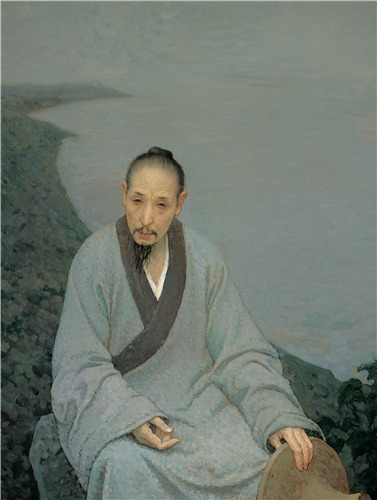 |
|
Bada Shanren, an oil painting by Jin Shangyi, is on display at A Tribute to Donors. [Photo provided to China Daily] |
Yang said at the donation ceremony in 2016 that Hsiung found a distinctive approach to sculpture by cutting iron into small pieces and forging them back to depict different subjects, "and the spaces between plates also constitute part of the work".
He recalls a bust of Hsiung's mother made by the artist. "I felt not only did Hsiung create a sculpture of his mother. Also, he presented a collective image of all the mothers in the world."
The donated sculptures were on show at The Journey of Defining Yourself, an exhibition to review Hsiung's accomplishments, held at the National Art Museum in January.
Also on display were 104 works received from Hsiung's widow, Xiong Bing'an. Selected works from the two donations are seen at A Tribute to Donors.
"Hsiung's work delivers a philosophical touch and reflects the spirit of a scholarly artist," says Wu, the museum director.
"What Yang gifted to the museum was a friendship that spanned some seven decades."
Wu says those who donate to the museum to share their collections of art with a wider audience are "great people", especially in a time when the art market is booming in China.
The four children of the late novelist Lao She and his wife, painter Hu Xieqing, donated dozens of classic Chinese paintings and calligraphy works collected by their parents to the National Art Museum in 2015.
The couple was on good terms with many artists and were themselves discerning collectors. Their assembly of artworks feature prominent artists such as Wu Changshuo, Qi Baishi and Fu Baoshi, and some of that can also be viewed at A Tribute to Donors.
The National Art Museum also does tours of its collections in other Chinese cities and abroad.
Master artist Wu Guanzhong held four solo exhibitions at the museum earlier. After his death in 2010, the museum mounted two more shows in his memory. He donated 46 of his paintings to the museum. Besides rotating the works on its exhibition calendar, the museum transports them outside.
In September, the Yixing Art Museum in Jiangsu province presented his works to commemorate his centennial. Yixing, a city known for its quality clay used in making Chinese teapots, is where the artist was born and raised.
Last year, the Beijing museum showed 36 paintings and sculptures in its collection at the China Cultural Center in Paris. It featured nearly 20 leading Chinese artists who studied in France in the 1920s, '30s and '40s. Part of the collection was donated.